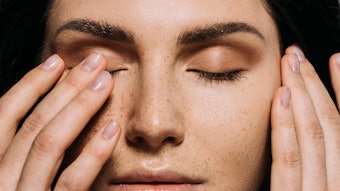
The complex process of skin melanogenesis renders many opportunities to identify novel means of controlling skin pigmentation. Melanin is the primary determinant of skin color in humans. The synthesis of skin melanin is primarily stimulated by ultraviolet (UV) irradiation which leads to the release of various autocrine and paracrine factors (i.e., α melanocyte stimulating hormone (α-MSH)) by keratinocytes. The keratinocyte-derived factors then bind to specific receptors (i.e. melanocortin 1 receptor (MC1R)) on melanocytes1 to activate a signal transduction process which, in turn, stimulates the expression of micropthalmia-associated transcription factor (MITF).2 The activity of MITF contributes to the expression of a host of genes that are involved in melanin production.3
Tyrosinase Inhibition
Within melanocytes, melanin is produced inside melanosomes using tyrosine as a precursor, and the key step is catalyzed by the enzyme tyrosinase. A classic way of controlling skin pigmentation involves the use of topically applied tyrosinase inhibitors, thus targeting the key enzymatic biosynthetic step.
Phytolight BG (INCI: Pyrus Malus (Apple) Fruit Extract (and) Cucumis Sativus (Cucumber) Fruit Extract (and) Butylene Glycol (and) Scutellaria Baicalensis Root Extract (and) Camelia Sinensis Leaf Extract (and) Disodium EDTA) is a unique blend of plant extracts stabilized by EDTA and sulfites that is a powerful inhibitor of tyrosinase.
Targeting Melanosome Maturation
Other enzymes like tyrosinase related protein 1 (TYRP1) and dopachrome tautomerase (DCT) also play important roles in the melanin biosynthesis process.4 Melanosomes are the cellular site of synthesis, storage and transport of melanin pigments. The biogenesis of melanosomes involes a complex process of maturation involving several factors like premelanosome protein (PMEL17), melanoma antigen recognized by T-cells 1 (MART1), ocular albinism type 1 (OA1), etc.5 Targeting the melanosome maturation process via inhibition of PMEL17 protein in melanocytes would be a novel and effective way of controlling skin pigmentation.
Actiwhite PW LS 9860 (INCI: Sodium Cocoyl Glutamate (and) Sucrose Dilaurate (and) Maltodextrin (and) Pisum Sativum Extract) is a blend of pea extract and sucrose dilaurate that not only targets the PMEL17 protein but is also an effective inhibitor of tyrosinase.
Actives such as Actiwhite PW LS 9860 that target multiple steps in melanogenesis could be expected to be more effective in controlling skin pigmentation. Indeed, Actiwhite PW LS 9860 was found in vivo to significantly lighten the skin with a reduction of pigmented spots and an improvement of the skin complexion and homogeneity of the skin color.
Melanosomes are then transferred from the dendrites of melanocytes to neighboring keratinocytes. In addition to UV and keratinocyte-derived factors, recent research has indicated that fibroblast-derived factors like dickkopf 1 (DKK1), SCF are also known to affect the process of melanosome transfer. Some of these factors like DKK1 inhibit the expression of protease activated receptor 2 (PAR-2), a receptor present on keratinocytes responsible for the uptake of melanosomes produced by melanocytes.6 Targeting the melanosome transfer process could provide innovative yet effective means of controlling skin pigmentation.
References
- JC Garcia-Borron, BLSanchez-Laorden and C Jimenez-Cervantes, Melanocortin-1 receptor structure and functional regulation, Pigment Cell Res 18 393-410 (2005)
- KW Vance and CR Goding, The transcription network regulating melanocyte development and melanoma, Pigment Cell Res 17 318-325 (2004)
- C Levy, M Khaled and DE Fisher, MITF: master regulator of melanocyte development and melanoma oncogene,Trends Mol Med 12 406-414 (2006)
- T Kondo and VJ Hearing, Update on the regulation of the mammalian melanocyte function and skin pigmentation. Expert Rev Dermatol. 6:97-108 (2011)
- JF Berson, DC Harper, D Tenza, G Raposo and MS Marks. Pmel17 initiates premelanosome morphogenesis within multivesicular bodies, Mol Biol Cell 12 3451-3464 (2001)
- M Seiberg, C Paine E Sharlow, P Andrade-Gordon, M Costanzo and M Eisinger et al, The protease-activated receptor 2 regulates pigmentation via keratinocyte-melanocyte interactions, Exp Cell Res 254 25–32 (2000)
Disclaimer:
The above paid-for content was produced by and posted on behalf of the Sponsor. Content provided is generated solely by the Sponsor or its affiliates, and it is the Sponsor’s responsibility for the accuracy, completeness and validity of all information included. Cosmetics & Toiletries takes steps to ensure that you will not confuse sponsored content with content produced by Cosmetics & Toiletries and governed by its editorial policy.










